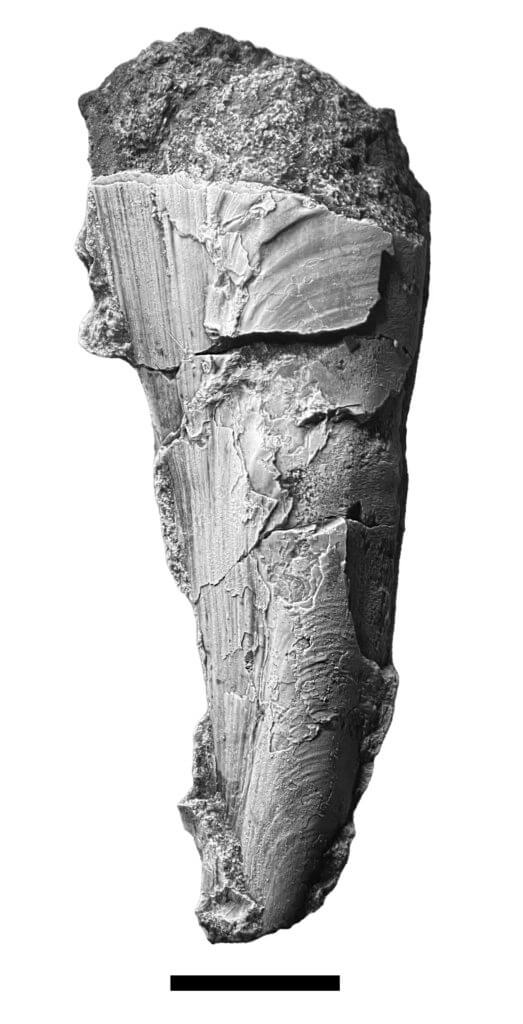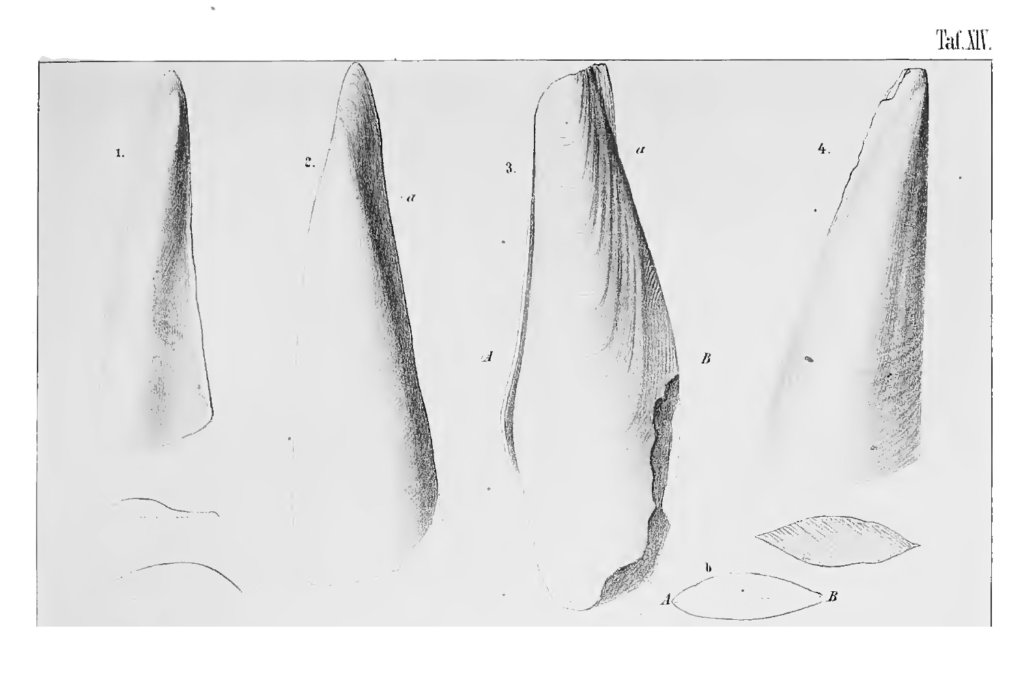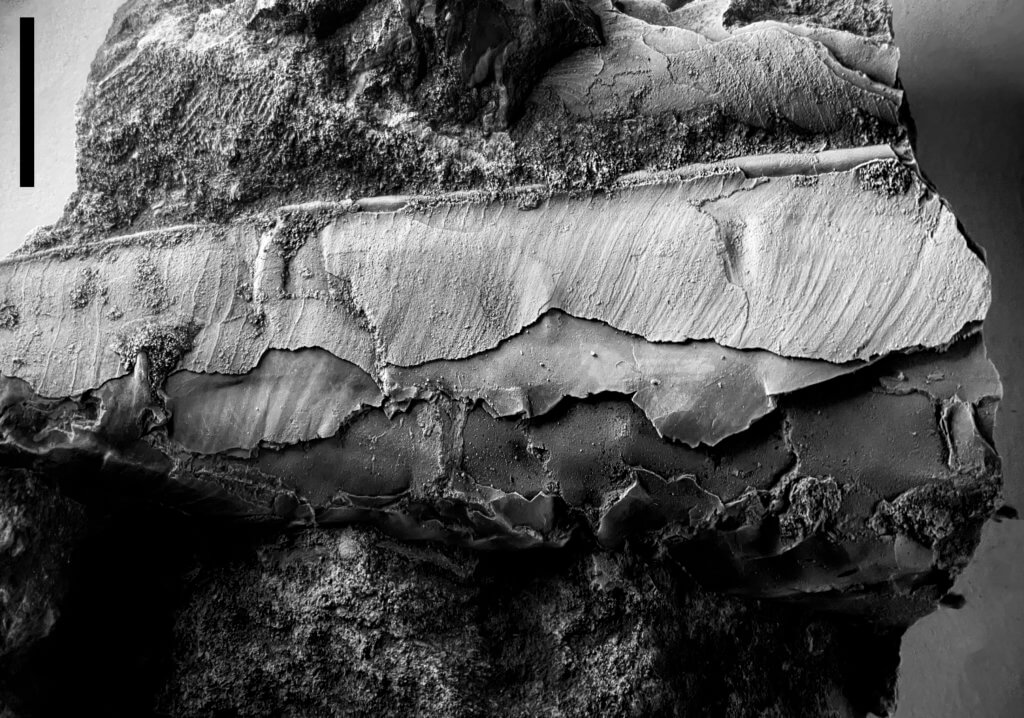Allopinna godleskya Yancey, 2024 is a new species of pinnid, defined by a round cross-section of its early shell (anterior) and the presence of upraised lamellae on the shell. I collected the holotype—and nearly one hundred additional specimens—from the Brush Creek limestone here in Parks Township. The holotype is deposited at the Carnegie Museum of Natural History as CM 54677, formally CG-0112. Nineteen paratypes were also designated, CM 54678–CM 54696

Thomas E. Yancey, an experienced paleontologist and professor emeritus at Texas A&M University, erected the genus and species in August 2024 in the Bulletins of American Paleontology, a peer-reviewed paleontological journal published since 1895. He named the pinnid genus Meekopinna in 1978. He writes often about bivalves (bivalvia), a mollusk class he knows exceptionally well. I wrote about Aviculopinna & Meekopinna in February of 2021, and not long after I posted it, Tom contacted me. After viewing my photographs, he felt that the pinnid fossils I was recovering were likely an undescribed species and wished to study them. His Summer travel plans enabled him to visit me in Parks Township, and he could examine them. I, in turn, donated twenty specimens for him to take back to Texas for a longer detailed study.
So, what is a Pinnid?
Pinnids—or members of the Pinnidae (Leach, 1819) family—are essentially marine clams. A clam is a general term for a bivalve, a mollusk with two shells that are a mirror image of each other. They live in both marine and freshwater environments. You can probably visit your local river or lake and find a few bivalves. They live underwater in three configurations: exposed on the surface, half-buried in the sediment, or wholly buried. Most clams filter feed by opening their shell and allowing water to enter.
Pinnids are marine (saltwater) creatures that live with their posterior buried in the sediment and their anterior end pointed upwards—see a photo of Pinna nobilis below for an example. They are most common in shallow seas below the tide line, and they avoid deeper water. This clue from modern pinnids can help inform researchers about the paleoenvironment in places where pinnid fossils are found.

Author: Hectonichus, Pinnidae – Pinna nobilis-001, CC BY-SA 3.0

Author: John Hill, Pinna noblis shell & byssus, CC BY-SA 3.0
Yancey Visits to Study Collected Pinnid Specimens
In May 2021, Dr. Yancey of Texas A&M University contacted me about pinnid specimens in my collection. I recently wrote the article Aviculopinna & Meekopinna, which provides an in-depth history of the two pinnid genera. The purpose was to help determine which genera of pinnids I was finding locally. In the article’s conclusion, I added several specimen photographs. One of my critical statements in the article was that I experienced a difficult time identifying my specimens. Midway through writing the article, I removed Aviculopinna and added Meekopinna as a target genus.
Yancey arrived on a June morning, and he and I spent half a day studying and examining every pinnid specimen I had collected to date—nearly 100 different specimens. He explained to me the importance of finding complete fossilized shell material. Each specimen helps show the nature of the growth lines and the general morphology of the shell. Pinnids are unique because they have a prismatic outermost layer easily identified using a hand lens or microscope.
At the end of the session, Yancey selected several specimens for use in photography and to represent holotypes and paratypes. A holotype represents a species, while a paratype sits aside the holotype to provide additional species context. The packaged specimens went to his lab in Texas for further preparation and study.
Waiting For Yancey’s Paper
One thing about paleontology is that discoveries can be quick, but documentation and discussion can be slow. It may appear that not much is happening in some areas. Nevertheless, descriptions of several new fossil species happen every week. After leaving with a box full of fossils, several steps remain.
Back to the Lab
First, the fossils arrive at the lab. Unless a subject is your primary focus, it may take several weeks, months, years, or even decades before they receive attention. Once in focus, a researcher reexamines all specimens to re-catalog and prepare the best specimens. While specimen CG-0112 (now CM 54677) was exceptional, small details were still hidden, requiring cleaning and removing the obscuring matrix. It was also heavy; workers removed large portions of the rock to reduce storage weight and space. After selecting a holotype, the specimens still need more critical pieces of work. These are:
- Name usage research.
- Complete research on related genera or families.
- A full technical description.
- Specimen measurements.
- Photographs.
Name usage research
While we have hundreds of thousands of Toms and Johns in the United States, a species cannot share a name with another under the same taxonomic parent. When naming Allopinna, the research must ensure nobody else named an Allopinna in the same family and further up the naming tree. I’ve also seen names shared between two creatures in different groups separated to avoid confusion. Checking a name is easier today than before; researchers amended many duplicate names because printed journals and mail systems took time to distribute information.
Complete research on related genera or families
As part of the research, a worker must be sure that a new species is precisely that, new. Collecting more than one specimen is important; a species named from one known example is highly suspect. Collecting more than one also gives a better average for the many details that define a species. Reviewing all of the journals may not be enough; quite a few species were misnamed or identified because of authors who compared using only published photographs or, worse, drawings.
The full technical descriptions
I often wish new species were given a visual treatment showing what makes them unique, but the required, proven, and accepted method is a full writeup to describe the species. Each detail should be described as completely as possible. The text will represent the species; getting this right is one of the most important parts of naming a new species.
Specimen measurements
Pictures with scale bars can say a thousand words, but providing detailed measurements of the holotype and paratype specimens is helpful. Outliers like the largest and smallest are further beneficial for future researchers, who will undoubtedly reference your work.
Photographs.
Modern photography is a staple in naming species. You can take a photograph more quickly today than ever. Sharp photographs illustrating key features will help future researchers quickly reference your species. It’s best to study specimens in person, but photos help reduce the legwork. Using a contrasting agent like ammonium chloride will make two-dimensional images appear with more depth and increase details lost to matrix colors.
Publishing to a Journal
Systematic paleontology is a method of fossil work that records the results of these types of work. Each is important but also subjective. For example, in 2001, in a review of systematic paleontology, an author wrote:
Technical aspects of paleontology are one of the most comprehensively ignored facets of our science, yet they control the nature of the data we present.
Jonathan M. Adrian, 2001
This comes from the frustration that specimen photography is inconsistent, even in the modern age. A common problem with many specimens described early in paleontology is the lack of a photograph or illustration. Workers would even imagine or draw the missing details on their specimens.

Another problem is that specimens become lost or destroyed. The chance of losing track of a fossil always increases as time increases. Any specimens collected in the 1800s are more likely to be lost. Wars are fought, and international borders change. Scientific institutions can change focus or fold entirely. Storage requires space, and space costs money. It wasn’t uncommon for early described specimens to be sold, given as presents, or passed on to relatives after death. The International Code of Zoological Nomenclature sets the modern rules, and if you don’t follow the rules, the scientific community will reject new, changed, or suppressed names.
Once the core work is complete, the manuscript is sent to a journal for peer review and acceptance. There are considerations for speed to publishing. If the work needs corrections during peer review, it will require a resubmission. If the journal has a large backlog, time will continue to increase. The submitted manuscript can take over a year to be accepted and longer until published. For this article, over three years have passed from the initial study until its final publication, partially due to the massive work put into the study and secondarily due to publishing delays of Bulletins of American Paleontology that have persisted during the Covid era.
The Importance of Depositing to a Museum
One further requirement is the deposit of every described specimen in a museum. This requirement allows future workers to compare specimens with new finds. A lack of available holotype specimens has caused significant difficulties in modern times. For example, the holotype for Petalodus ohioensis only exists as a couple of casts in different museums. J. M. Safford kept the specimen for himself; its whereabouts are unknown. In 2019, Wayne Itano and Kenneth Carpenter directly questioned the validity of P. ohioensis as the type for the genus in North America. Only a poorly preserved cast represented the species. Fortunately, the pair found a better cast (FMNH PF 673) at the Field Museum in Chicago.
Presenting Allopinna godleskya
After discovering the holotype CM 54677 (previously CG-0112) in 2019, I sent photos to John Harper, my primary invertebrate paleontology mentor. The specimen impressed him; he described it as one of the best he had ever seen in the local section. I took the assessment seriously and have always held it in high regard in my catalog. I was indeed lucky; no specimen after has presented itself in the same way.
Allopinna godleskya is both a new species and a new genus. Yancey named Allopinna to place species with the inflated shell of Orthopinna combined with the ornamentation and posterior margin of Meekopinna. The upturned shell lamellae are standard on modern pinnids but were only previously known in the Paleozoic on Meekopinna. It further distances itself from Meekopinna due to its slender anterior shell width and thick secondary shell layer secretions (Yancey, 2024).
Yancey selected CG-0112 as the holotype for the species based on its highly complete shell morphology. Growth lines present in great detail and terminate on the shell’s dorsal and ventral margins. Most shells don’t survive removal from the limestone, but CM 54677 was exceptional in surface detail.
References
- Anelli, L.E. & Rocha-Campos, A.C., Simoes, M.G., 2016, Pennsylvanian Pteriomorphian bivalves from the Piaui Formation, Parnaiba Basin, Brazil., Journal of Paleontology – V80, Issue 6, pp. 1125-1141.
- Dauphin, Y. et al., 2018, The Prismatic Layer of Pinna: A Showcase of Methodological Problems and Preconceived Hypotheses, Minerals, 19 Pages.
- Geinitz, H. B., 1848, Die Versteinerungen des Deutschen Zechsteinge-birges. Dresden, p. 77, Plate XIV
- Hoare, R.D., 1979, Bulletin 67: Pennsylvanian Marine Bivalvia and Rostroconchia of Ohio, State of Ohio Div. of Geological Survey
- Meek, F.B., 1864, Remarks on the family Pteriidae, (=Aviculidae) with descriptions of some new fossil genera. The American Journal of Science and Arts, Second Series 37, pp. 212-220
- Munster, G.G., 1840, Beschreibung einiger seltenen Versteinerungen des Zechsteins. Beiträge zur Petrefacten-Kunde, p 45, Tab 3, Figure 4
- Shumard, B.F., Swallow, G.C., 1858, Descriptions of new fossils from the coal measures of Missouri and Kansas., St. Louis Academy of Science Transactions, p. 214
- Waller, T.R., 1978, Morphology, morphoclines, and a new classification of the Pteriomorphia (Mollusca: Bivalvia). Philosophical Transactions of the Royal Society of London (B), 248, pp. 345–365
- Yancey, T.E., 1978, Brachiopods and mollusks of the Lower Permian Arcturus Group, Nevada and Utah, Pt. 1, Brachiopods, scaphopods, rostroconchs and bivalves. American Paleontology Bulletins, 74(303), pp. 257–363
- Yancey, T.E., Amler, M., Raczyński, P., & Brandt, S., 2023, Rebuilding the foundation of late Paleozoic pinnid bivalve study (family Pinnidae). Journal of Paleontology, 97(1), pp. 140-151.
- Yancey, T.E., 2024, Revision of Late Paleozoic Pinnid Genera and North American Species of Bivalve Family Pinnidae, Paleontological Research Institution, p. 84
- 2021. Pinna nobilis, Wikipedia


